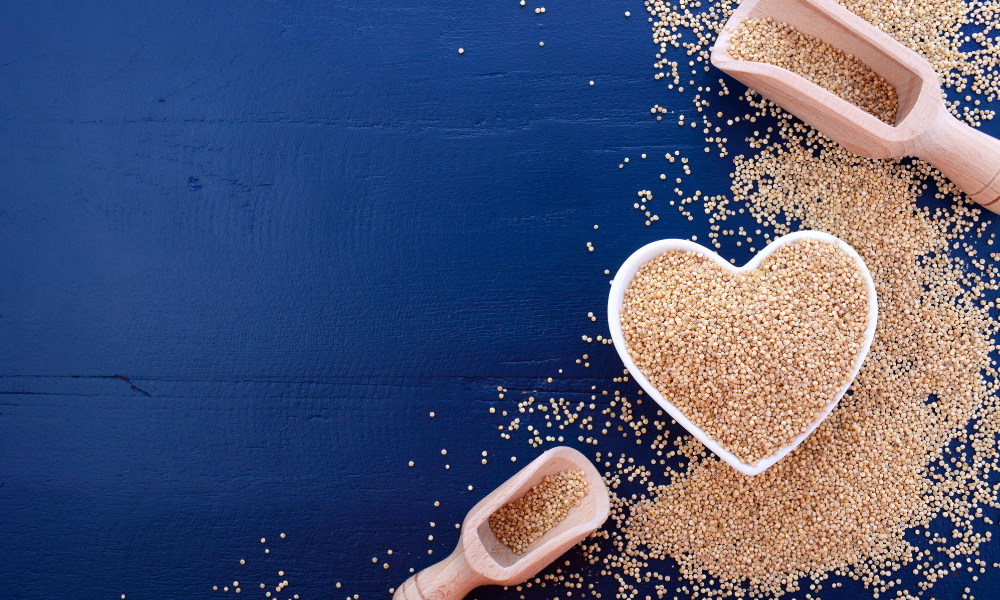“Inca Gold” or “Inca Wheat” – these and other names are used to advertise a mixture that consists of two well-known pseudo-cereals: quinoa and amaranth. When combined, they are said to work wonders for your health. We will take a closer look in this article and explain how quinoa and amaranth affect the body.
The Gold of the Incas
Amaranth (a member of the Amaranth family) and quinoa (a member of the goosefoot family) have been cultivated in the high plateaus of the Andes for several thousand years and are used as a staple food there. The Spanish conquerors in the 16th century even banned their cultivation under penalty of death. Their aim was to weaken the indigenous peoples and thus minimize the risk of an uprising.
Inca Gold is a natural food supplement that contains finely ground quinoa and amaranth seeds. Thanks to its ingredients, it is rich in tryptophan, long-chain carbohydrates, minerals, protein, trace elements and vitamins.
The positive effect of these two plants on the human organism has been known in South America for thousands of years. Although quinoa and amaranth are pseudo-cereals, they can be processed in a similar way to other types of cereals and are a tasty alternative to them. In the form of high-quality capsules, they can also be conveniently taken daily with a glass of water.
Quinoa
As a pseudo-cereal, quinoa is not related to the well-known types of grain, but rather to plants such as chard, spinach and beetroot. Quinoa has only recently become a trendy food that is available worldwide.
The plant, revered by the Incas as the “mother of all grains,” is a good source of the amino acid tryptophan, which in turn is responsible for the production of the happiness hormone serotonin.
There are three main types of quinoa: white, red and black. 100 grams of the grains contain a total of 335 calories, of which 59 grams are carbohydrates and 5 grams are fat. In addition, there is also a small amount of omega-3 fatty acids.

amaranth
Amaranth (locally known as kiwicha ) is a group of more than 60 different types of grain that have been cultivated for around 8,000 years. Like quinoa, amaranth was a staple food in the cultures of the Aztecs, Mayans and Incas. Although not technically a cereal grain like oats or wheat, amaranth is nevertheless used in a similar way and has a comparable amount of nutrients.
Aside from its versatility, this nutritious grain is naturally gluten-free and rich in protein, fiber, micronutrients and antioxidants . What's more, amaranth is packed with manganese, an element that is particularly important for brain function and is said to protect against neurological diseases.

How Inca gold could support health
There are hardly any studies on the effectiveness of the amaranth-quinoa mixture. However, there are scientific studies that have looked at quinoa and amaranth individually.
Could increase the activity of antioxidants
Antioxidants are compounds that help fight harmful free radicals in the body. Free radicals can damage cells and contribute to the development of chronic diseases.
A study published in the journal Plant Foods for Human Nutrition finds that amaranth can increase the activity of antioxidants and also helps protect the liver from alcohol.
Two antioxidants that have been particularly well studied are quercetin and kaempferol, both of which are found in high amounts in quinoa.
In fact, the quercetin content in quinoa is even higher than in comparable foods with a high quercetin content, such as cranberries, according to a study presented in the Korean Journal of Food Science and Technology and also on the website of the Food and Agriculture Organization of the United Nations .
Provides building blocks for serotonin
Hormones have a very strong influence on our health and our mood. Serotonin, known as the "happiness hormone", plays a key role in sadness, fear or depression. It also controls our appetite, pain sensation, body temperature, sleep and perception.
In order for the body to produce sufficient amounts of serotonin, it must have access to essential building blocks. One of these is the essential amino acid tryptophan, which the body cannot produce itself.
Furthermore, sufficient amounts of magnesium , manganese, zinc , B vitamins and vitamin C , as well as omega-3 fatty acids are also necessary. Quinoa and amaranth provide all of these building blocks.
Provides potentially anti-inflammatory ingredients
Inflammation is a normal immune response designed to protect the body from injury and infection. However, chronic inflammation can lead to chronic diseases and is linked to cancer, diabetes and autoimmune diseases, among others, according to a 2012 study.
A comparative study in the journal Molecular Nutrition & Food Research found that amaranth reduced several inflammatory markers.
Certain substances in quinoa also showed anti-inflammatory effects in a 2014 study.

Blood sugar & cholesterol levels
Cholesterol is a substance that is similar to fat and is found throughout the body. However, too much cholesterol can build up in the blood and cause narrowing of the arteries. A study on hamsters showed that amaranth oil reduced total cholesterol and "bad" LDL cholesterol by 15 percent and 22 percent, respectively. In addition, amaranth grain reduced "bad" LDL cholesterol while increasing "good" HDL cholesterol.
Eating foods that have a high glycemic index (a measure of how quickly foods raise your blood sugar levels) can trigger hunger and contribute to obesity, according to a clinical study titled "High glycemic index foods, overeating, and obesity" published in 1999.
Such foods have also been linked to many of the common chronic Western diseases such as type 2 diabetes and heart disease. Quinoa has a low glycemic index and is therefore well suited for diabetics .
However, you should note that quinoa is still quite high in carbohydrates, so it is not a good choice if you are following a low-carb diet.
Could contribute to weight loss
Amaranth and quinoa are rich in protein and fiber and could therefore aid weight loss.
A 2009 study that followed 252 women for 20 months found that increased fiber intake was associated with a lower risk of weight and body fat gain.
The fact that quinoa has a low glycemic index is another important property, since the choice of such foods is associated with reduced calorie intake.
A gluten-free alternative
Gluten is a natural protein found in grains such as wheat, spelt, barley and rye, among others. While many of the most commonly consumed grains contain gluten, amaranth and quinoa are naturally gluten-free and can be eaten by those on a gluten-free diet.
A study published in the Journal of Human Nutrition and Dietetics found that using quinoa instead of typical gluten-free ingredients such as refined corn, rice, tapioca and potato flour can actually increase the nutrient content of the diet.
Conclusion: How valuable is Inca gold?
The mixture of amaranth and quinoa, known as “Inca Gold,” is said to work wonders for the body. However, there is currently no reliable study on whether the interaction of the two pseudocereals is more beneficial than the effect of each on its own.
However, each of these plants shows promising approaches when it comes to, for example, the production of serotonin, the inhibition of inflammation, a positive influence on cholesterol or blood sugar levels and weight loss.
In any case, both taste good and their nutritional content makes them a good change for your diet.
[1] https://nutritiondata.self.com/facts/cereal-grains-and-pasta/10352/2
[2] https://pubmed.ncbi.nlm.nih.gov/12505649/
[3] https://www.ncbi.nlm.nih.gov/pmc/articles/PMC3614697/
[4] https://pubmed.ncbi.nlm.nih.gov/21547507/
[5] https://pubmed.ncbi.nlm.nih.gov/18537130/
[6] https://www.sciencedirect.com/science/article/abs/pii/S0308814609011662
[7] https://www.ncbi.nlm.nih.gov/pmc/articles/PMC4393508/
[8] https://www.ncbi.nlm.nih.gov/pmc/articles/PMC3492709/
[9] https://pubmed.ncbi.nlm.nih.gov/24431078/
[10] https://pubmed.ncbi.nlm.nih.gov/24712559/
[11] https://pubmed.ncbi.nlm.nih.gov/12690910/
[12] https://pubmed.ncbi.nlm.nih.gov/10049982/
[13] http://www.glycemicindex.com/foodSearch.php?num=927&ak=detail
[14] https://pubmed.ncbi.nlm.nih.gov/19158230/
[15] https://onlinelibrary.wiley.com/doi/abs/10.1111/j.1753-4887.2000.tb01855.x
[16] https://pubmed.ncbi.nlm.nih.gov/19519750/

















